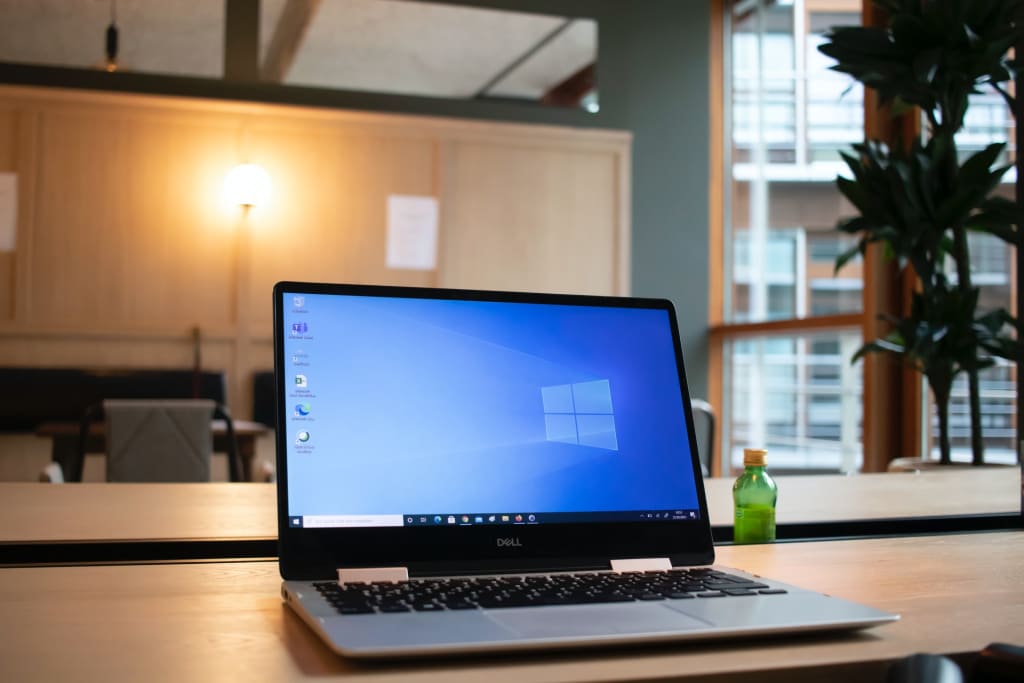
The State of Personal computers
Personal computers are arguably one of the most popular piece of technology that has been around the last decades.
Since its inception in 1975, Microsoft has ventured into many new projects but none have been as successful as their home operating software systems named Windows.
Windows gained much traction and popularity from Windows XP released in the year 2000.
After that Microsoft has kept updating its prized possession in the following years in which some of which were a huge success whereas others were a letdown.
Windows 10
Windows 10 is the latest in this long line of operating software and it is the second most popular Windows OS after Windows 7.
It packs a wallop of features and is the most visually pleasing ecosystem out of the windows family. It was released in 2015 after its predecessor 8.1 which did not perform well.
Microsoft wanted to make up for its previous mistakes and Windows 10 was the answer to it. This update lived up to its promises and ensured a good user experience overall.
But the downside to it was Microsoft has been pushing a lot of bloatware and preloaded apps that hindered the performance and usability of the OS.
Unless your system is a power pact machine equipped with the latest hardware you will experience some kind of lagging in your system. Your Pc may take a long time to boot up or your PC may freeze up just when you're in something important.
I've been there and I understand your pain so in this article I will be giving you some tips to resolve these problems to some extent so that you can have a better PC experience.
Before I start this article I would like to remind you that nothing beats a hardware upgrade like buying some RAM sticks or adding an SSD to your arsenal.
But if you're computer doesn't support upgrading or you can't spend money on expensive hardware then this article will be super useful for you.
Visual Effects
As I have mentioned Windows 10 has a visually pleasing interface (well, at least that's what I think) with its glossy and transparent tiles and more.
But there's a catch to it and it is a bit on the slower side especially if you have a moderate system configuration. If you're like me and you may value performance and usability over looks and aesthetics.
In this step, we will be disabling some of the basic bells and whistles that windows have packed into the operating software. the first one is going opaque instead of transparent.
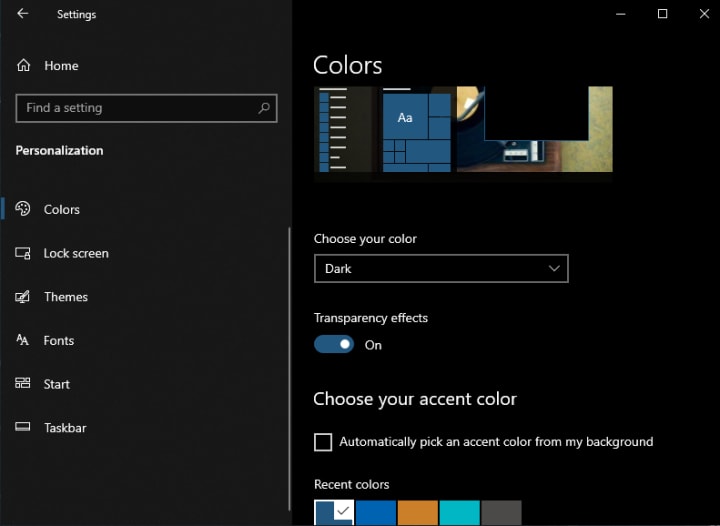
Disable all Visual Effects
In the earlier step we just touched the tip of the iceberg, now this is where we disable all kinds of visual effects according to your taste.
A side note here- after disabling these you may feel a bit alien using your computer after disabling these effects so select 'Custom' and see what works best with you.
For disabling this go to settings and go to system and scroll all the way down to about after that scroll down a bit where you will find Advanced system settings. Then a small window will pop up and you can select the needed options given below.
Proceed and select custom if you want to decide which visualize effects to keep and which one to get rid of.
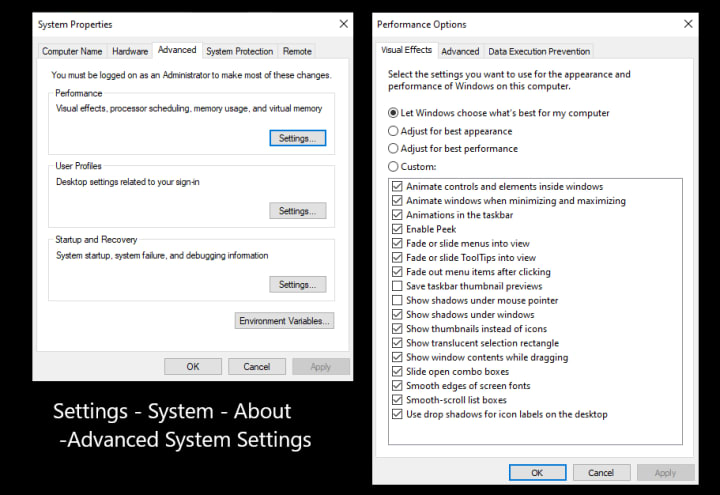
Additional tips and Tweaks
Adjusting Power Plan
This is a simple tweak but hey, every small step matters, right? If you're on windows 10 chances are you are currently on a "power saver" plan.
What this basically does is that it optimizes performance in order to prioritize saving power.
For accessing this feature go to Control panel > Hardware and sound options > Power options, most probably it may be set to balanced or power saver plan you can also see another option underneath this called high Performance.
Select whichever option you seem fit, if you're on a desktop any one of them would suit you, but if you're on a laptop I would advice you that you stick to 'power saver' when not connected to a battery source and 'balanced' when plugged in.
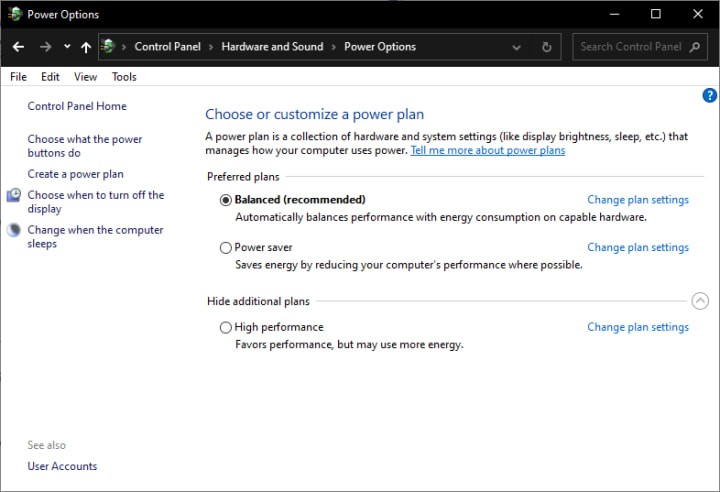
OneDrive
Windows has graciously offered us with OneDrive and its 5 GB worth of cloud space for free, but let's be honest majority of us don't even use that OneDrive (maybe you do and that's completely fine, just skip ahead) I know I don't.
Well whether you use it or not, OneDrive always runs in the background taking your computer's resources which slows down your computer, so what I did was disabling it.
You can also disable it by clicking the OneDrive icon in the taskbar or by going to start. Skip to the end where I will be giving a quick fix for completely uninstalling it.
Startup Applications
One of the most excruciating feelings is that time when you want to get your Pc to open up instantly. If you're extremely patient and not in hurry this won't be even a thing and you couldn't care less about this.
But that's not why you clicked on this article, isn't it? We want our Pc to run like a charm and one of the ways you can do that is by disabling startup applications. For this hit the lifesaver combination CTRL+SHIFT+ESC
Then move to the Startup tab and disable the unwanted apps by right-clicking and proceeding .
Updates and Windows
Windows 10 is notorious for updating in the background and sometimes just shutting down with not a single regard for the user.
But despite this, the updates are actually good for you and your PC, they safeguard your system from malware and keeps it snappy. So update your system and check your drivers are well once in a while.
Even though, Windows updating in the background will steal your bandwidth and may as well force you into an update.
I don't like this one bit and in addition, it slows down our system because of all the background processes. There are two options for this you can disable or either turn off automatic updates.
Either way, you should be check for updates at least once a week.
I will link down a video and it is a complete guide for disabling updates both on Windows home as well as the pro version.
Debloat Windows using this Script
Yes, you heard that right in this last step we will be using a script for removing crapware.
This tool is a lifesaver because this toolbox handles the hassle of scouring through different control panel tabs to find a specific feature.
If you're interested in tech and you follow tech channels on YouTube you are most likely to have heard of Chris from Chris Titus Tech. He's is a great guy and he always makes videos in a way that anyone can understand him and follow along.
I came upon his debloater script in one of his videos and decided to give it a go, and I have to say this if you wanna level up your PC without sacrificing any penny, this is the way to go.
So basically what he did was he build a toolbox that can completely delete all the unwanted bloatware or add any additional features that you may need.
For this, we have to access Windows PowerShell as admin and paste the below command, and press enter.
Here's the script down below-
iex ((New-Object System.Net.WebClient).DownloadString('https://git.io/JJ8R4'))
Or if you'd like to read the full and decide if it's worth running on your PC you can always go to his website and read more about it.
Here's a snapshot of the toolbox on my PC.
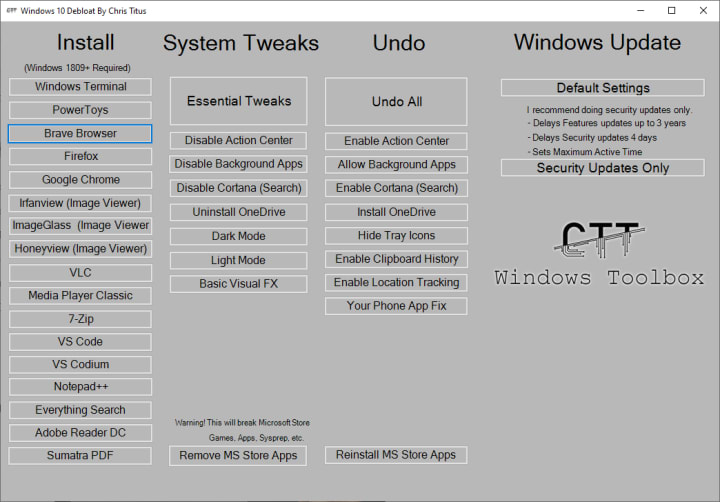
Conclusion
Windows is a great software and it powers most of our devices at our homes and offices.
So it is important that we make the most out of it, all of these tips and tweaks are tried and tested on my pc at home and they work very well in providing me with a better experience with windows.
These tips should work with all pc's running windows 10 so go ahead and make your system faster.
Thanks.
About the Creator
J.Maria
Musician/ Writer






Comments
There are no comments for this story
Be the first to respond and start the conversation.